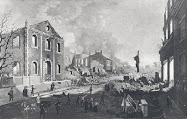Take Me to the River. Finally.
By NATHAN WARD
New York Times - July 2, 2010
THIS summer, with the debut of the Brooklyn Bridge Park, as well as the expansion of Manhattan’s Hudson River Park and Governors Island, New Yorkers have celebrated the reclamation of the waterfront. But the effort, laudable though it is, obscures a not-so-insignificant historical misunderstanding: we are in fact claiming the waterfront, not reclaiming it.
From New York’s early days as a port to its receding days as a manufacturing town, the waterfront was never a place most people wanted to be. It was always a rough, strange world separate from the city it surrounds.
In the Colonial era, the waterfront was the province of those who wanted to go to sea, or at least to unload ships. Cargo-laden clipper ships entering the harbor produced a call for “Men Along the Shore!” — longshoremen. Back then, those men with the patience to keep alert for the flare or flag of an approaching vessel and the physical strength to “bull” cargo were really the only people allowed near the docks.
During the 19th century and early 20th century, the docks were a place of dangerous work done by often desperate men, many of them immigrants. In the 1915 study “The Longshoremen,” the sociologist Charles Barnes described an occupation that “involves such constant risk that a man becomes ‘work hardened’ or indifferent to the dangers around him.” Barnes authenticated 309 longshore accidents on the Manhattan waterfront, 96 of them fatal, in a single year.
By the middle of the 20th century, New York Harbor was the greatest port in the world, with more than 900 working piers. But as commerce boomed, so too did crime. The small-time heists by pre-Prohibition gangs gave way to territorial murders and organized pilferage. (Pier 45 at West Street, now a pastoral portion of the Hudson River Park, was so gang-ridden it couldn’t be rented out.)
Malcolm “Mike” Johnson, whose investigations for the old New York Sun won a Pulitzer Prize in 1949, called the city’s docks at the time a “waterfront jungle.” Murders, he wrote, are “commonplace, a logical product of widespread gangsterism.” Stealing was so rampant it amounted to an unofficial — and hefty — tax. One steamship company, the Grace Line, lost nearly $3 million in 1948 alone, 80 percent of it from its New York piers. The bolder pier heists of the era included an entire truck-sized electrical generator and a 10-ton shipment of steel.
The authorities were hampered by a waterfront “code” against squealing that was no Hollywood invention. “A man could be killed in broad daylight before half a dozen witnesses and nobody would testify about it,” wrote William Keating, a New York assistant district attorney. “On the waterfront, to talk was to rat, and to rat was to stand exposed and unprotected.” Dozens and dozens of murders went unsolved.
Not surprisingly, in 1931, when The New Yorker sent Alva Johnston to Irishtown — now the loft country of Dumbo — to investigate the deaths of 21 Brooklyn stevedores, he discovered that there had been no arrests, “not because there is anything secret or underhand about these murders, but because the witnesses won’t talk.” When detectives asked the wounded Red Donnelly, the Brooklyn dock boss, what enemy had balehooked and shot him in a waterfront shanty on Bridge Street, he coughed out, “John Doe” — and died pure.
Read the rest of this article here:
-



No comments:
Post a Comment